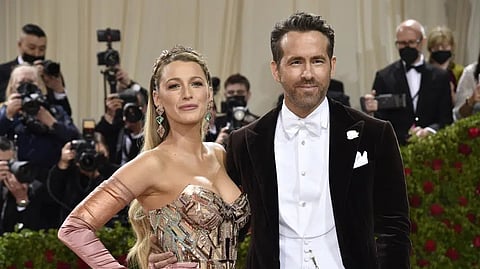

NEW YORK: The season’s triple-virus threat notwithstanding, parties are back, and they’ve brought with them the potential for some dress code chaos.
White tie, black tie, black tie creative/festive, semiformal: It might take some extra re-entry energy to figure out these pre-pandemic guidelines in an exhausted world more used to sweats and sneakers.
Invitations sometimes don’t specify attire, leaving it until the RSVP phase or expecting guests to infer based on experience or an event’s description. That was perhaps easier pre-pandemic, but many people are ready to take on the challenge, shed their cozy, casual duds and dress up once again.
“The stories I’m hearing from people is that they’re happy for an opportunity to get out of the sweatpants,” said Lizzie Post, Emily Post’s great-great-granddaughter and co-author of a rejuvenated new edition of “Emily Post’s Etiquette” to mark the book’s centennial.
With help from the Posts, a rundown from the most formal to the least formal attire:
WHITE TIE
This, the most formal traditional attire, involves a white bow tie, black jacket with tails, matching trousers and white vests for evening. Swap in a morning coat for day.
Think royal events, ultra-galas or super formal weddings.
“I think the thing that people are most unsure about is formal attire because most of us have few occasions to ever wear it,” Post said. “That’s one most people get stressed about, but it’s a category that’s pretty well-defined.” By well-defined, she means: trousers with a satin or braid stripe; plain-front, wing-collar, French cuff shirts; stiff white pique vests; cuff links or studs; black or white braces; black socks; and black patent-leather pumps or lace-up Oxfords. Studs for buttons or covered buttons are options.
Chesterfield coats, which are formal, dark-colored and knee-length with velvet collars, are suitable as outerwear for cold weather, as opposed to one’s down parka.
Gowns are floor length, or possibly VERY formal two-piece outfits, with optional gloves of varying lengths. A dress-pant combo is rare.
BLACK TIE
It’s the next most formal attire, and means tuxedos in black or midnight blue. Collars can be wing or regular in white. Bow ties are black. So are braces or suspenders. Vests are optional, but forget the cummerbund if a vest is worn.
Not any cummerbund will do. Make sure it matches bow tie and lapel fabrics. Footwear is the same as white tie. White dinner jackets are acceptable in the summer or warm climates.
Gowns are floor length here, too, but can be more casual than white tie in materials and structure. A very formal cocktail dress might do if the hemline is at or below the knee.
Black tie is far more familiar to many than white tie, Post said.
BLACK TIE/CREATIVE/FESTIVE:
Attire is the same as black tie but with colors or embellishment added for a bit more dazzle.
For dresses and two-piece outfits, there’s some wiggle room to experiment with color, texture and accessories, Post said.
“It’s where you get the groomsman of a wedding wearing flip-flops instead of shoes because the wedding is at the beach and everything’s going to be on the sand,” she said.
“Given our day and age, people really like to be explicit on invitations for semiformal. Cocktail attire is a subset of this,” Post said.
BUSINESS ATTIRE:
Dressing for work varies widely, but when business attire shows up on an invitation, tradition may kick in.
The safest bet is suits and ties, button dress shirts, belts and dress shoes. Dress slacks or trousers with a dressy top are acceptable, along with a conservative dress (nothing too low-cut, short or luxurious), and close-toed shoes, all depending on how fashion-forward the crowd is expected to be.
“It’s still important to be you,” Post urged.
BUSINESS CASUAL:
Things get confusing here, too.
Many who have returned to work are living in this zone, but what it means depends on the industry or company environment. It could mean a suit or seasonal jacket worn with no tie and trousers, or dress jeans with button-down or polo shirts or sweaters.
Dress slacks or trousers with a more casual top might do the trick. The same is true of a skirt-and-top combo, though nothing too short or low cut, depending on the event.
If an invitation says business casual, it may be up to you to figure out what’s acceptable.
DRESSY CASUAL:
A little less tricky, but still dizzying.
It can mean jeans and a sweater or a casual button shirt. It also means dress pants and a casual top, or casual pants and a dress top.
Comfortable dresses or skirt-and-top combos also work. The best part: any shoes.
“You want to feel out any event to make sure,” Post said.
CASUAL:
Almost anything goes. Almost.
Jeans, shorts, T-shirts, pullovers, hoodies, tank tops, dress or skirt with any top, any shoes.
There are lines that can be crossed, however. Casual doesn’t mean unkempt. Leave the stained T-shirt at home, and perhaps the ripped jeans, too.
“I think we’re all out of practice with these delineations, for sure,” Post said. “There’s been a gray haze of attire for most of us.”
Visit news.dtnext.in to explore our interactive epaper!
Download the DT Next app for more exciting features!
Click here for iOS
Click here for Android